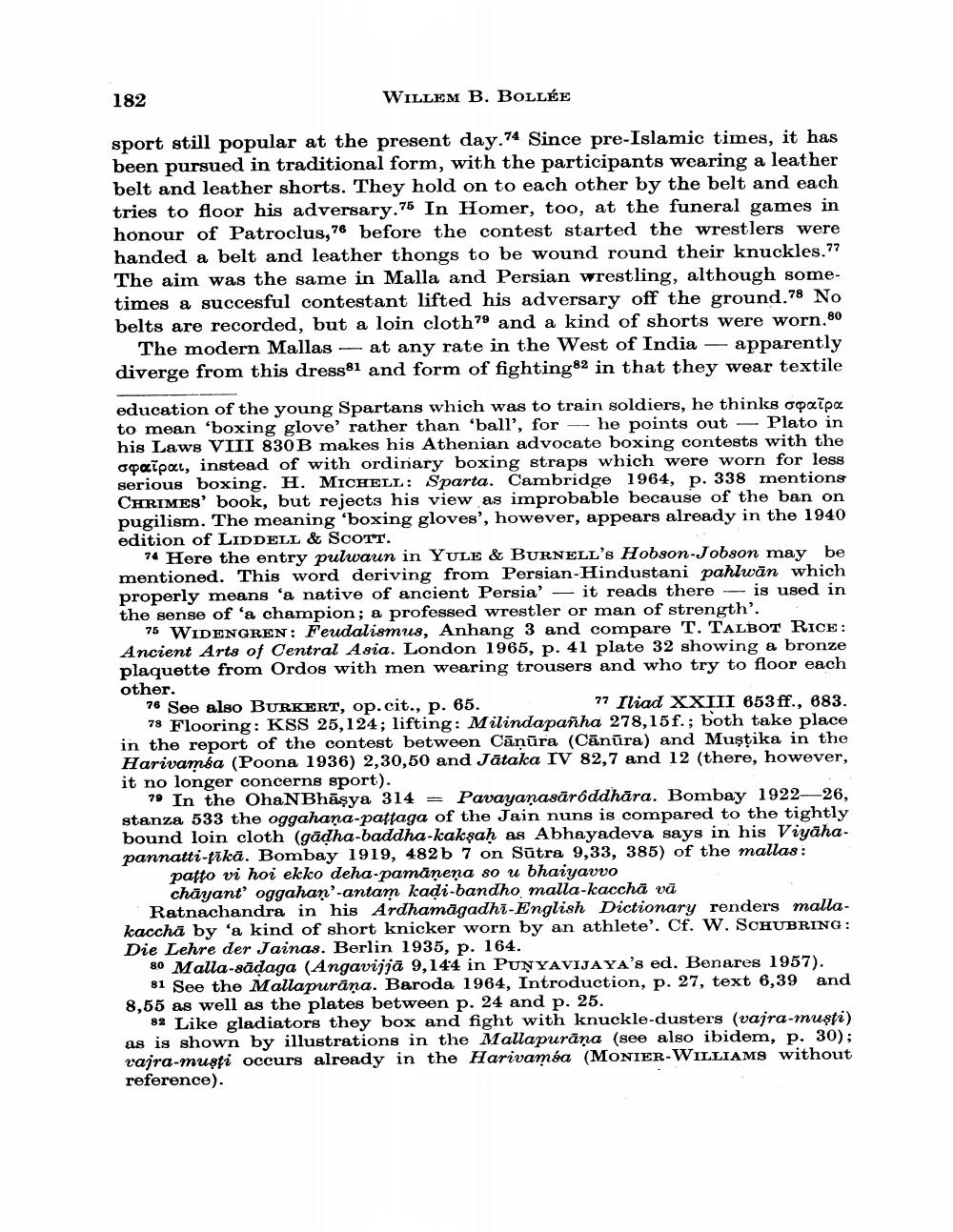________________
182
WILLEM B. BOLLÉE
sport still popular at the present day.74 Since pre-Islamic times, it has been pursued in traditional form, with the participants wearing a leather belt and leather shorts. They hold on to each other by the belt and each tries to floor his adversary.75 In Homer, too, at the funeral games in honour of Patroclus, 76 before the contest started the wrestlers were handed a belt and leather thongs to be wound round their knuckles.77 The aim was the same in Malla and Persian wrestling, although sometimes a succesful contestant lifted his adversary off the ground.78 No belts are recorded, but a loin cloth 79 and a kind of shorts were worn.80
The modern Mallas --- at any rate in the West of India — apparently diverge from this dress 81 and form of fighting82 in that they wear textile
education of the young Spartans which was to train soldiers, he thinks opapa to mean 'boxing glove' rather than 'ball', for — he points out Plato in his Laws VIII 830 B makes his Athenian advocate boxing contests with the opaipai, instead of with ordinary boxing straps which were worn for less serious boxing. H. MICHELL: Sparta. Cambridge 1964, p. 338 mentions CHRIMES' book, but rejects his view as improbable because of the ban on pugilism. The meaning 'boxing gloves', however, appears already in the 1940 edition of LIDDELL & SCOTT.
74 Here the entry pulwaun in YULE & BURNELL's Hobson-Jobson may be mentioned. This word deriving from Persian-Hindustani pahlwān which properly means 'a native of ancient Persia' — it reads there — is used in the sense of 'a champion; a professed wrestler or man of strength'.
75 WIDENGREN: Feudalismus, Anhang 3 and compare T. TALBOT RICE: Ancient Arts of Central Asia. London 1965, p. 41 plate 32 showing a bronze plaquette from Ordos with men wearing trousers and who try to floor each other. 76 See also BURKERT, op.cit., p. 65.
77 Iliad XXIII 653 ff., 683. 78 Flooring: KSS 25,124; lifting: Milindapañha 278,15f.; both take place in the report of the contest between Cāņūra (Cānūra) and Mustika in the Harivamsa (Poona 1936) 2,30,50 and Jātaka IV 82,7 and 12 (there, however, it no longer concerns sport).
79 In the OhaNBhāşya 314 = Pavayanasārôddhāra. Bombay 1922—26, stanza 533 the oggahana-pattaga of the Jain nuns is compared to the tightly bound loin cloth (gādha-baddha-kakşah as Abhayadeva says in his Viyahapannatti-ikā. Bombay 1919, 482b 7 on Sūtra 9,33, 385) of the mallas:
patto vi hoi ekko deha-pamänena so u bhaiyavvo
chāyant' oggahan'-antam kadi-bandho malla-kacchā vā Ratnachandra in his Ardhamāgadhi-English Dictionary renders mallakacchā by 'a kind of short knicker worn by an athlete'. Cf. W.SCHUBRING: Die Lehre der Jainas. Berlin 1935, p. 164.
80 Malla-sādaga (Angavijja 9,144 in PUNYAVIJAYA's ed. Benares 1957).
81 See the Mallapurāņa. Baroda 1964, Introduction, p. 27, text 6,39 and 8,55 as well as the plates between p. 24 and p. 25.
82 Like gladiators they box and fight with knuckle-dusters (vajra-musti) as is shown by illustrations in the Mallapurāna (see also ibidem, p. 30); vajra-musti occurs already in the Harivamsa (MONIER-WILLIAMS without reference).




